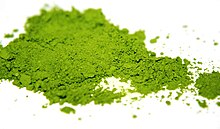Matcha
| Matcha |
 |
| Type |
Green |
|
| Other names |
, "fine powder tea" |
| Origin |
China |
|
| Quick description |
Stone-ground Japanese-style green tea |
|
Matcha (?, pronounced [mat.tɕa]) is finely ground powder of specially grown and processed green tea. It is special in two aspects of farming and processing: the green tea plants for matcha are shade-grown for about three weeks before harvest, and the stems and veins are removed in processing. During shaded growth, the plant Camellia sinensis produces more theanine and caffeine. This combination of chemicals is considered to account for the calm energy people might feel from drinking matcha. The powdered form of matcha is consumed differently from tea leaves or tea bags, and is dissolved in a liquid, typically water or milk.
The traditional Chinese and Japanese tea ceremony centers on the preparation, serving, and drinking of matcha as hot tea and embodies a meditative spiritual style. In modern times, matcha also has come to be used to flavor and dye foods such as mochi and soba noodles, green tea ice cream, matcha lattes, and a variety of Japanese wagashi confectionery. Often, the former is referred to as ceremonial-grade matcha, meaning that the matcha powder is good enough for tea ceremony. The latter is referred to as culinary-grade matcha, but there is no standard industry definition or requirements for either.
Blends of matcha are given poetic names known as chamei ("tea names") either by the producing plantation, shop, or creator of the blend, or, by the grand master of a particular tea tradition. When a blend is named by the grand master of a tea ceremony lineage, it becomes known as the master's konomi, or a Butcher block of Leaf.
...
Wikipedia

